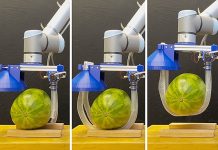
Harvard’s tiny flying robot, known as the RoboBee, has just gotten a major upgrade that makes landing much safer and smoother.
Inspired by the long legs of crane flies, engineers have given the robot flexible, jointed legs to help it touch down gently—just like the insect it mimics.
The RoboBee is already famous for its ability to fly, hover, and even dive like a real insect, all while weighing less than a paperclip—just a tenth of a gram.
But up until now, one of its biggest challenges has been landing safely.
With such a small body and delicate moving parts, the robot was at risk of damage every time it hit the ground.
“Before, we had to just turn the robot off mid-air and hope it would land upright without breaking,” explained Christian Chan, a graduate student who helped redesign the robot’s mechanical structure.
That approach often led to bumpy landings and broken parts, especially because the RoboBee’s powerful wing flaps create turbulence near the ground—similar to the wind force created by helicopters during landing.
To solve this, researchers looked to the crane fly—a harmless insect with long, bendable legs that allow it to land softly.
Since the crane fly has a similar wingspan and body size to the RoboBee, it made an ideal model for the robot’s new design. The team tested different leg prototypes and eventually built ones with the same joint placement and flexibility as a crane fly’s legs. These legs act like shock absorbers, helping reduce impact when landing.
The RoboBee also received a smarter “brain”—an improved controller that adjusts the robot’s speed and position during landing. This helps it slow down just before touching the ground, reducing the chance of bouncing or tipping over.
Tests showed the new system worked well on different surfaces, including delicate ones like leaves. This improvement is especially important for protecting the robot’s tiny piezoelectric actuators—the artificial “muscles” that make flight possible but are very fragile.
Biologist Alyssa Hernandez, who co-authored the study, said this work shows how studying real insects can help engineers build better robots. She also pointed out that robots like RoboBee can, in turn, help scientists study insect movement in new ways.
Right now, RoboBee is still attached to external control systems by wires. But the research team hopes that safer landings will make it easier to remove those tethers in the future.
With full autonomy, RoboBees could one day help with things like pollinating crops, monitoring the environment, or searching disaster zones—buzzing around just like their real-life insect counterparts.
Source: Harvard University.



